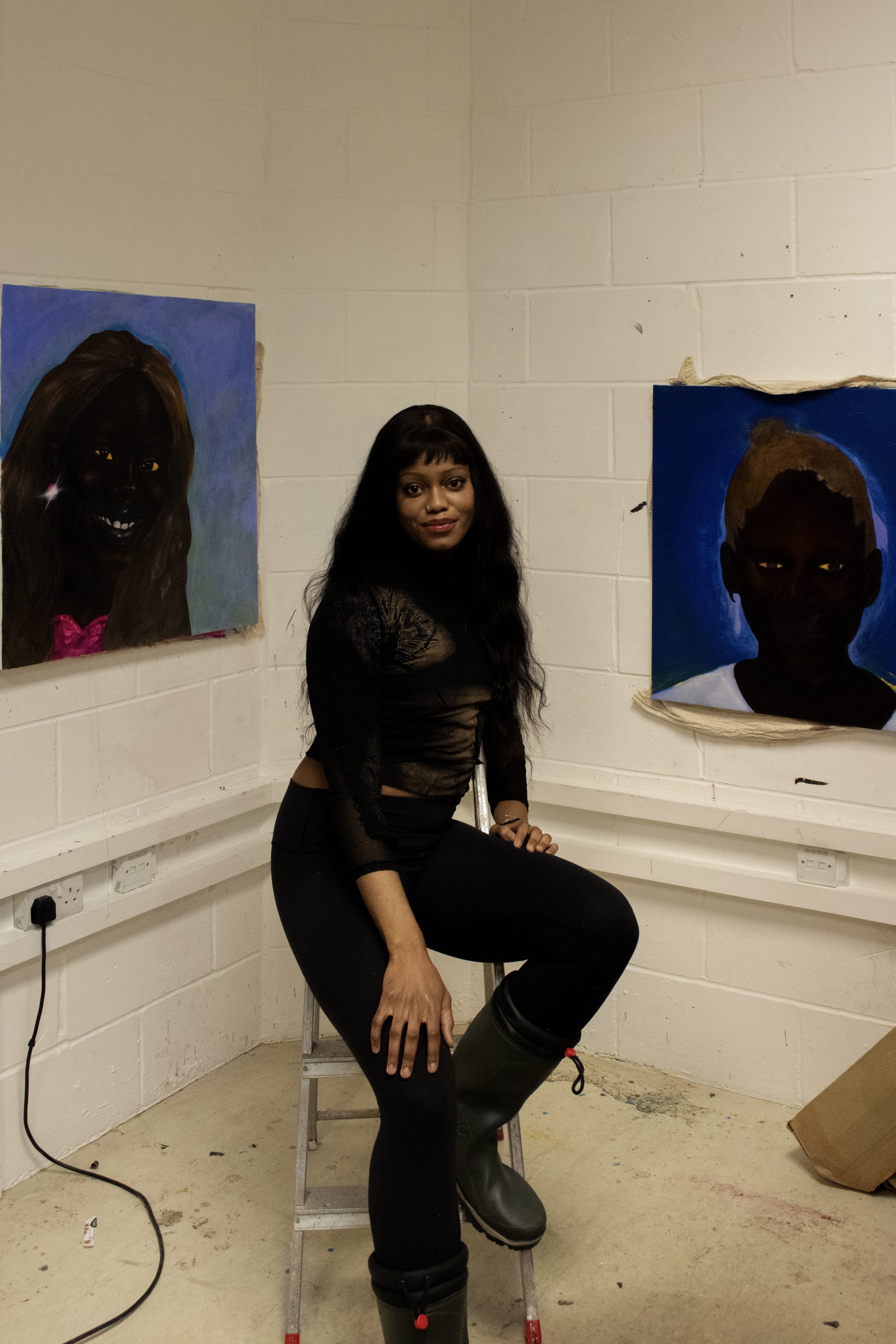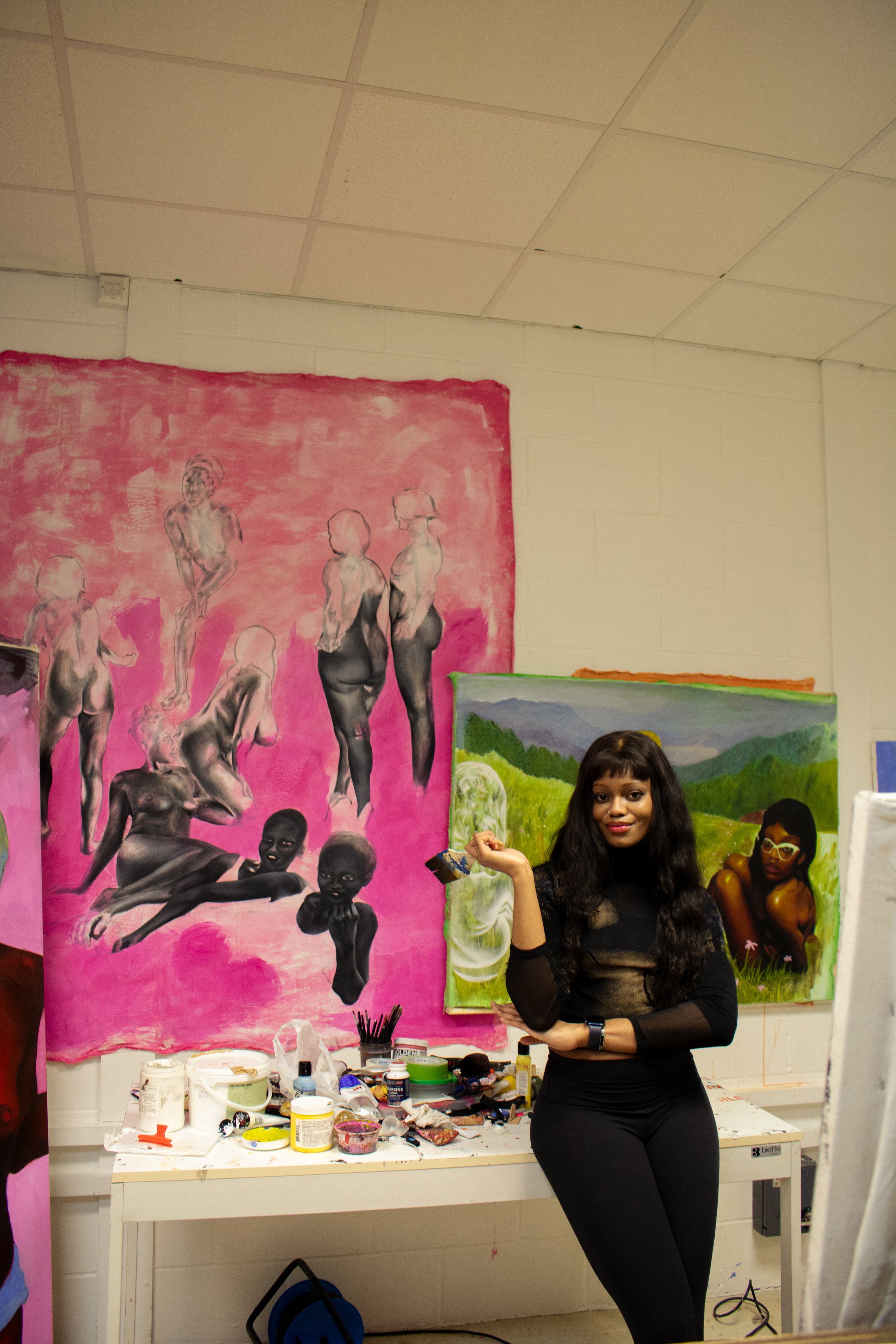From Identity Limbo to Debut Solo Shows: an Interview with Chinaza Agbor
By Temilayo Benson
Stepping into the studio of an artist before a show is like stepping into the bedroom of a girl before she goes out. You get to see the inner workings behind the final product, both explicit and implicit.
Chinaza Agbor’s Brighton studio was full of warm colour and the smell of fresh paint; depicting many parts of Chinaza, including herself (in a self-portrait) and her heritage. Ahead of her debut solo show, I got to (literally) sit down with the Texan-Nigerian artist in the hallway outside her studio.
Layo Benson: How's your day been?
Chinaza Agbor: Good! How has your day been?
LB: It’s been good. I haven’t been to Brighton in a year and a half!
CA: No, go and explore. There are definitely new things to see. Lots of places open and close here all the time. A lot of good food.
LB: So, from Texas to Brighton is a big move. What prompted the move from the Royal College of Art in London to Brighton?
CA: When I was at RCA, it was mostly during COVID. I can say I only had one full semester where I was actually in school before COVID. After that [semester] there were strikes, and then COVID happened, so it was hectic.
I had to do school online in London, and it was a lot. I’m a suburban girl at heart and so London was too much for me. I wasn’t used to all of the noise. I visited Brighton because my friend lives here, and I fell in love with it when I came.
LB: How did you find your time at RCA, and what advice would you give to your 21 year old self trying to make it?
CA: RCA was great when I attended physically. I’d never been in an artist’s institution where I was allowed to be so free and talk about art freely with my peers. I think people underestimate the power of sitting with other artists just talking and thinking freely.
My advice to myself would be: work harder. Go to studio, do the things you’re meant to. I needed to stop gallivanting around London and start gallivanting to my classes.
LB: Texas has quite a large community of first-gen Nigerian immigrants. Were you surrounded by other Africans in the same circumstances growing up?
CA: Yes, I was surrounded by lots of other Africans like me. UNT (the university I went to) was actually referred to as “Little Africa”, so I was always surrounded by Nigerian people. I never felt like I was missing out on that connection; obviously it’s very different from being in Nigeria itself, but I was always surrounded by the culture. I never felt like I was lacking in that sense, I was always exposed to it; my household was very cultural, my parents were very Nigerian, even though they were very American, too.
LB: How do you think that connection has aided in your experience of blackness in America? Furthermore, do you feel a disconnect between your African diasporic experience of blackness and the African American experience of blackness, since they are rooted in oppression through colonialism and slavery, respectively?
CA: Because I’ve experienced black American culture and Nigerian culture equally, it always left me feeling as though I was in limbo. I never really fully understood where I fit in. I was always this awkward, artsy, black girl, so a lot of the Nigerians around me did not relate to me. I still loved being around my people, but sometimes I felt uncomfortable because I always felt like there was a part of me that I couldn’t fully display because people around me wouldn’t understand. It made me more open to being uncomfortable.
The two parts are very much so a part of me; I’m equally Nigerian and black American. Especially being from the South, that Southern black experience is very different to the experience of other black people. And I think a lot of other Southern Nigerians could relate to this. It’s a lot. That doesn’t, however, make it less unique or beautiful an experience.
LB: What does your creative process look like? If you had to describe it in three words, what would they be? Is it messy, or organised? Chaotic, or calm?
CA: A lot of dreaming. Lots of colour. And very raw. I used to shy away from investigating myself and digging deeper into my work; I didn’t want people to see me bare on the canvas. Now, though, I very much so enjoy that. I like exploring myself and feel as though I learn more about myself through my work.
I feel like a lot of my work now accurately represents who I am. I’m literally naked in a bonnet in one of the pieces for my new show. It’s incredibly raw; I would never have let anyone see me like that, but in the last few years, I really wanted to describe my experience. Who I am, what I’m going through, and who I am becoming. I couldn’t do that [exploration of self] if I’m not open with what I bare unto the canvas. I am nervous for people to see me that way, but I enjoy everything I’ve learned whilst actually painting, so I can’t complain.
LB: How do you find the balance between your work being commercial enough to sell but still authentic to your creative mind? Do you find that you still have to take it as much into consideration at this point in your career?
CA: I think that is the main crux of being a contemporary artist. There is a fine line between making art that will sell and also making art that satisfies you. When you know composition, and colour, and things that look good, I feel that it will automatically sell. I’m very knowledgeable in those aspects, and so I can naturally add those things into my work. It has been a long process of figuring out the balance between being [creatively] open with myself and being real with myself about the fact that I have to live off this work, too, so it has to sell. The balance is something that changes with each painting, and I need to constantly ask myself throughout the painting process if what I’m doing will lure in an audience and cause people to stop and stare. It’s very gratifying for people to look at my work and think, “Wow, I’ve never seen something like this”. I want uniqueness, but for the art to still be beautiful.
LB: You come from a science background (like I do). In what ways would you say your background has given you an advantage? What knowledge/ skills have you transferred that you expected and that surprised you?
CA: Because I don’t come from a traditional art background, the same rules don’t apply to me. A lot of people that came from these art institutions have these set rules that I don’t. I just saw art as an expression of freedom compared to my science background. Sure I have rules for my own practice, but I feel like I’m more open to challenging myself and exploring new things. Since I had to seek art in the first place, I continue to do that now through teaching myself how to do things so they look the way I want them to.
LB: Looking through your previous work, I noticed that the style in which you highlight black bodies has changed since 2022. Was that a subconscious change or done with intent? If so, what did you want to convey by using more subtle dimensional techniques?
CA: I got better at painting. That’s all it was. I realised that what I was doing with the intense highlights was kind of corny to me, and discovered ways to convey that glowing within the skin without it being so intense. No message intended, I’ve just gotten better at rendering [laughs].
LB: What elements of a piece make you decide on the appropriate medium? Some of your pieces are mixed media, whilst others are solely oil on canvas.
CA: A lot of the time, being an artist means using what’s in front of you. If you only have paper or markers, you’re going to do something and still find ways to create. My preference is oil on canvas because there’s no greater experience than working through an oil painting. You’re constantly working it, constantly evolving it, and you could keep going until the sun came home. So, I enjoy discovering that point to stop just before I go too far.
However, oil paints and canvases can get very expensive, and there was a time in COVID (especially during strict lockdowns) where I had no access to that. I made do with what I had to flesh out that creative part of me while using media like markers and paper. And that was an important journey, because now I can create anything out of anything and enjoy it, too.
LB: You do figurative art, and I’ve noticed that a lot of black artists are encouraged to either do figurative art or abstract art. In what ways do you explore other aspects of art, if any?
CA: I wouldn’t categorise my art as extreme realism; I feel like I walk the line between figurative and abstract art. That’s what keeps me going and makes every piece interesting. I’m always collaborating those two sides of me.
Though I was encouraged to pursue figurative art, that encouragement didn’t feel too unnatural since I already loved drawing and connecting with people. It had always been a passion of mine since before formal training. A lot of the time you can tell when that isn’t the case, and I try to avoid putting myself into a box so I never reach that point. If I woke up and wanted to paint scenery, I would do that. I have a natural connection to people, though, and I like to paint people in a way that feels like they’re looking into you whilst you look into them.
LB: I love that. What does a typical day at the studio look like for Chinaza Agbor?
CA: I truly do the same thing everyday: I come in, turn on my iPad and turn on the latest show I’m watching (I like long, narrative shows, and right now I’m watching X-Files and Severance), and I just paint and watch my show (loudly). I usually have a tea during my breaks. I’m rolling my chair between each piece I’m working on, so whilst one is too wet, I can work on another. I repeat this cycle until I get too tired and go home each night.
LB: I need to start Severance! I’ve heard such good things about it.
CA: It’s so good! Very scary, but so good.
LB: What keeps your motivation up? Who/ what are your current inspirations?
CA: My best friends. They are the most creative, driven people I’ve ever met. In high school, my level of laziness could be likened to that of a sloth, and what really made me motivated to succeed was seeing my friends Ciara Boniface and Mikaela Dapremont do the things they said they wanted to. It’s because of them that I have what my ex called “crazy American drive”.
They will always be my inspirations because of that, too.
LB: I feel like having a really solid support group is really important.
CA: It helps so much! My parents weren’t the most supportive of the art stuff at first. Now they are, but at the beginning when we had disagreements, my friends were my biggest cheerleaders even when others weren’t. I appreciate them a lot; they are the reason I am here today.
LB: What are your dreams today? What are you most excited for in the next six months?
CA: First, I’m excited for whatever happens after this show. I want people to come to me after they’ve seen the show and say “wow, I’ve never seen anything like that. I love what I saw.” That’s what will please me the most in the next few weeks.
In the next six months? I’m going back to Texas for a few months, so we never know. I used to plan every part of my life but now I’m very open to things happening. Maybe a residency, but who knows. Hopefully I get another show.
LB: What are the dreams of yesterday that you’ve achieved and not given yourself the space to acknowledge?
CA: Dreams not acknowledged: all of them [laughs]. There are the bigger goals that will probably happen in the coming years, but most goals I’ve had (like the show coming up, schooling) haven’t been celebrated. I got them, and once I got it, I was already looking to the next. You’re right, I should pat myself on the back more.
LB: I feel like all creatives struggle to take time and bask in the fact that they’ve actually achieved something they wanted to do.
CA: Yeah. We should. Though sometimes I ask myself, “why would I worry about this thing I’ve achieved when I could be doing even better?” It’s a terrible cycle to be in.
Chinaza’s debut solo exhibition, ‘Kindness and Hospitality from a Foreigner’, opens to the public at Cob Gallery in London from Saturday, November 25th and will be available to view until December 16th, 2023.
Link for Ciara’s website
Link for Mikaela’s website








